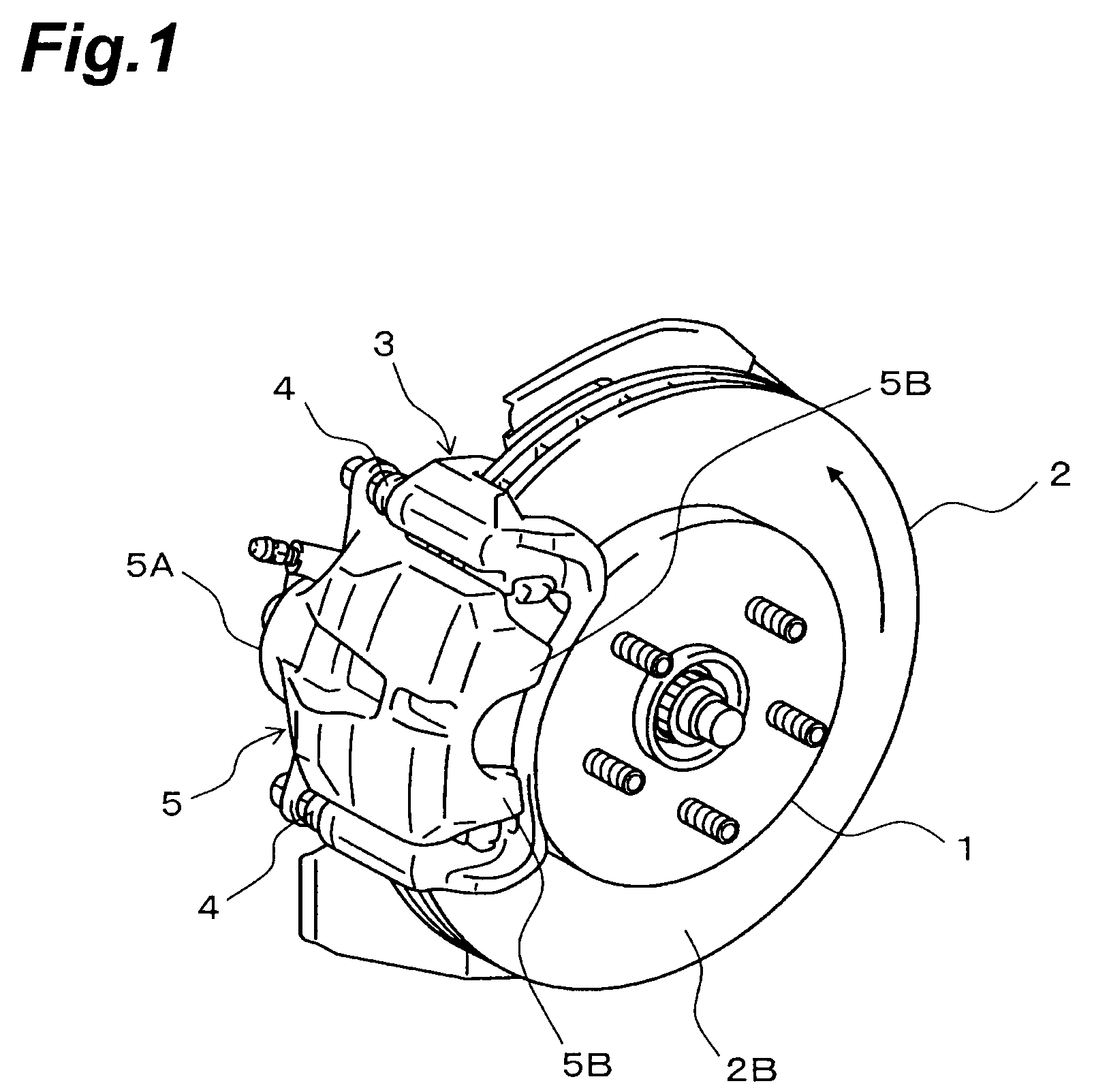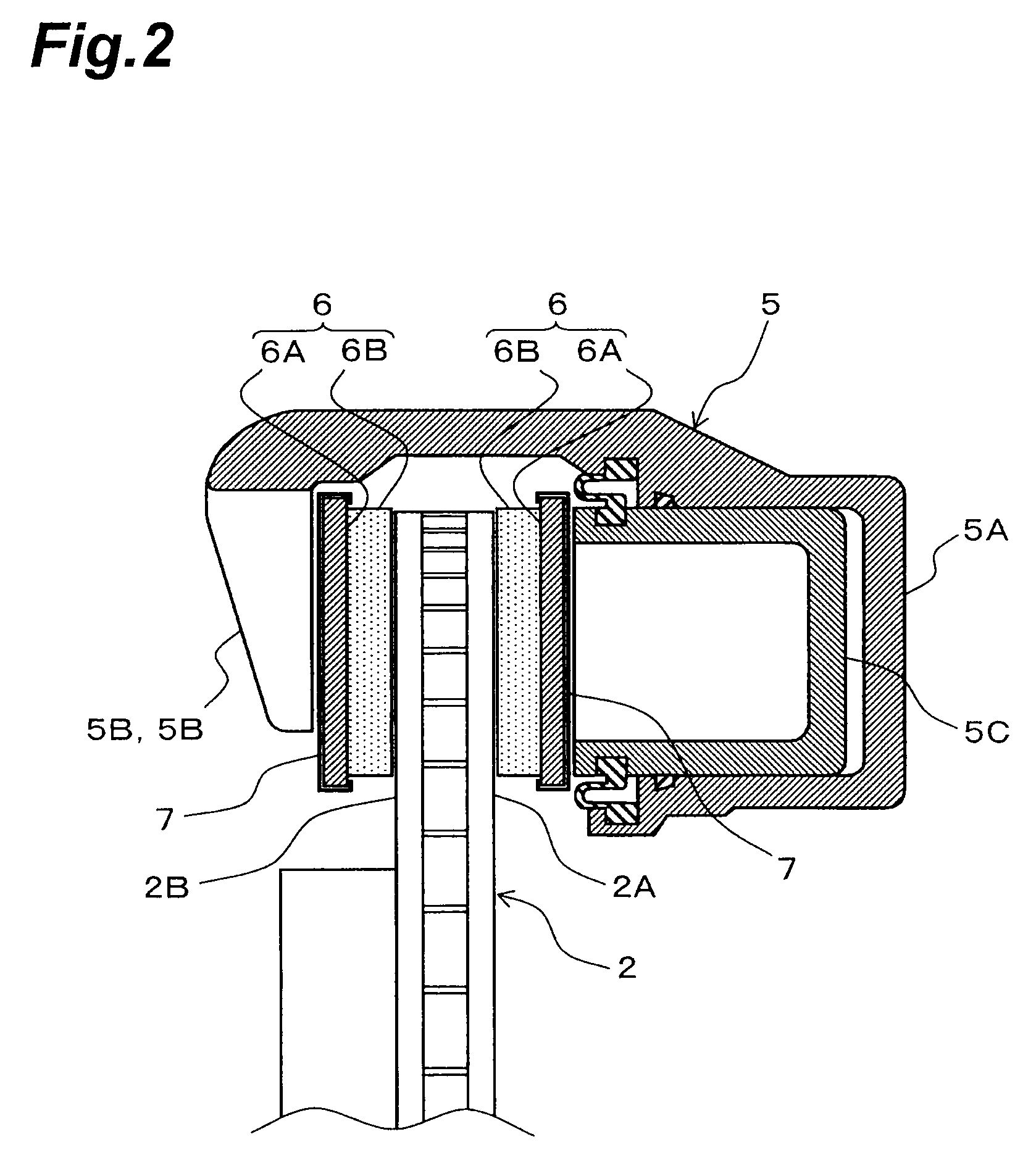Disc brake device
a disc brake and disc technology, applied in the direction of noise/vibration control, slack adjusters, braking elements, etc., can solve the problems that the disc brake apparatus described in patent document 1 and the disc brake apparatus described in patent document 2 cannot be expected to securely restrain clunking sounds from occurring, so as to achieve the effect of convenient us
- Summary
- Abstract
- Description
- Claims
- Application Information
AI Technical Summary
Benefits of technology
Problems solved by technology
Method used
Image
Examples
first embodiment
[0045]In the following, embodiments of the disc brake apparatus in accordance with the present invention will be explained with reference to the drawings. Among the drawings for reference, FIG. 1 is a perspective view showing the exterior of the disc brake apparatus in accordance with the present invention, FIG. 2 is a partial sectional view schematically showing a cross-sectional structure of a caliper in the disc brake apparatus shown in FIG. 1, and FIG. 3 is a side view schematically showing the disc brake apparatus shown in FIG. 1.
[0046]The disc brake apparatus in accordance with the first embodiment, which is constructed for a vehicle, comprises a disc rotor 2 which is secured to a hub 1 of an axle so as to rotate integrally therewith, a torque member 3 which is supported by a suspension part or the like (not depicted) of a vehicle body and arranged such as to stride over an outer peripheral part of the disc rotor 2, and a floating caliper 5 which is attached to the torque memb...
second embodiment
[0067]The switching holding means of the disc brake apparatus in accordance with the second embodiment is constructed as shown in FIG. 9, for example. Namely, in the second torque transmission part 6D of the backing metal 6A of the brake pad 6, a pair of first engaging recesses 6G, 6G and a pair of second engaging recesses 6H, 6H are formed adjacent to each other on both surfaces facing the inner and outer sides of the disc rotor 2 in the radial direction. Correspondingly, the second pad retainer 9 attached to the second torque receiving part 3D of the torque member 3 is integrally formed with a pair of spring pieces 9B, 9B.
[0068]The pair of first engaging recesses 6G, 6G and the pair of second engaging recesses 6H, 6H are formed like V-grooves, while the pair of spring pieces 9B, 9B have leading end parts bent such as to be selectively engageable with the first engaging recesses 6G, 6G or second engaging recesses 6H, 6H. Namely, when the brake pad 6 shifts toward the first torque r...
third embodiment
[0076]The switching holding means of the disc brake apparatus in accordance with the third embodiment is constructed as shown in FIG. 12, for example. Namely, a pair of first permanent magnets 11, 11 for attracting the first torque transmission part 6C of the backing metal 6A of the brake pad 6 are buried in the first torque receiving part 3C of the torque member 3, while a pair of second permanent magnets 12, 12 for attracting the second torque transmission part 6D of the backing metal 6A of the brake pad 6 are buried in the second torque receiving part 3D of the torque member 3.
[0077]The pair of first permanent magnets 11, 11 are arranged separately from each other in the radial direction of the disc rotor 2 such as to attract the first torque transmission part 6C of the backing metal 6A evenly. Similarly, the pair of second permanent magnets 12, 12 are arranged separately from each other in the radial direction of the disc rotor 2 such as to attract the second torque transmission...
PUM
 Login to View More
Login to View More Abstract
Description
Claims
Application Information
 Login to View More
Login to View More - R&D
- Intellectual Property
- Life Sciences
- Materials
- Tech Scout
- Unparalleled Data Quality
- Higher Quality Content
- 60% Fewer Hallucinations
Browse by: Latest US Patents, China's latest patents, Technical Efficacy Thesaurus, Application Domain, Technology Topic, Popular Technical Reports.
© 2025 PatSnap. All rights reserved.Legal|Privacy policy|Modern Slavery Act Transparency Statement|Sitemap|About US| Contact US: help@patsnap.com



